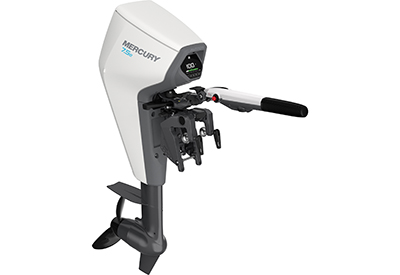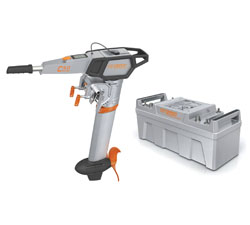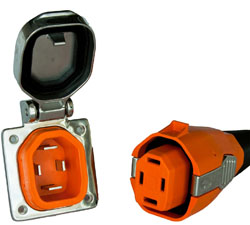POWER PLAY

Hate running the generator all night and getting little sleep? New lithium-ion battery systems are changing the face of boating, bringing new capabilities and incredible benefits – for a price.
By Craig Ritchie
We all know the story. You’ve been on the water since early morning, you’ve managed a tricky navigation through unfamiliar waters, but you’ve finally arrived! Drop the hook in a spectacular, quiet bay, enjoy a lovely dinner and a bottle of wine, then close your eyes and enjoy a peaceful night gunkholed under the stars, to fall asleep to the gentle serenade of the crickets and the haunting cry of the loon. Except you can’t hear the crickets, you can’t hear the loons and you can barely hear your own thoughts over the incessant hum of that bloody generator.
There’s no way you’re shutting off the air conditioning on such a hot summer’s night. But there’s also no way you’re ever going to sleep with all that noise. Sound familiar? Trust me – you’re in good company.
From the smallest open fishing boats to the largest luxury yachts, the heart of any vessel on the water these days is its DC power system because, to put it succinctly, without power nothing else works. The stereo, the air conditioner, the TV, the GPS – nothing. As we continue adding more and more high-tech goodies to our boats, we are ever more reliant on a steady flow of power to make them all work.
It is this ever-increasing need for power that has put unprecedented demands on marine electrical systems. Although individual products may be increasingly energy efficient, the simple fact we keep adding more and more of them onboard tends to cancel out any gains we might have made – especially since we seem to want to run them all at once. So whether they draw power continuously like our radios and MFDs, or suck it up in surges the way bow thrusters, windlasses and galley appliances do, the net result is the same – our demand for electrical power is enormous, and incessant.
 Mastervolt Lithium-Ion Battery Lineup.
Mastervolt Lithium-Ion Battery Lineup.
The evidence can be seen below the deck of any modern boat. Where cruising yachts were once almost universally powered by simple 12-volt systems, today we’re seeing 24-volt systems and 36-volt systems more and more often. Yet even those are sometimes challenged to keep everything humming as it should.
Little wonder then that serious cruisers are among the leading champions of new lithium-ion battery systems coming to market. Smaller, lighter and far more potent than traditional lead acid cells, lithium-ion batteries are revolutionizing boat systems just as they have revolutionized everything else, from campers to mobile phones.
Power To Burn
For years boaters have relied on deep-cycle batteries to power their electric accessories, including wet-cell lead acid batteries that you have to occasionally top up with water, and both gel and Absorbent Glass Mat (AGM) lead acid batteries which are sealed and require no maintenance. While AGM represented a clear improvement over older-technology gel batteries – and the even older wet cell types – when it first came to market, at the end of the day even today’s latest AGM batteries still represent an incremental update to what is an old technology.
Lithium-ion batteries, by comparison, are a next-generation design that outperforms lead acid batteries in a multitude of ways, starting with far longer run times. Donald Hasler, strategic account manager for Canadian power system manufacturer Xantrex, notes that the maximum point of discharge for a traditional lead acid battery is to a level that’s around 50 percent of its total capacity. In other words, your 900-amp battery is only good to about 450 amps before it’s effectively done. Drawing it down beyond that level can significantly shorten the battery’s life, says Hasler, and will likely void the manufacturer’s warranty.
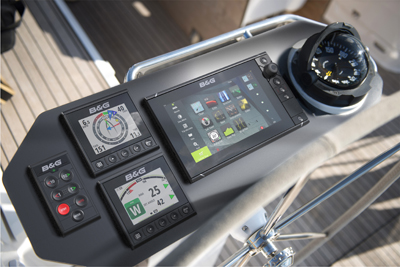 Solar panels can offset parasitic losses to equipment left on for extended periods while giving batteries a steady trickle charge.
Solar panels can offset parasitic losses to equipment left on for extended periods while giving batteries a steady trickle charge.
By comparison, a lithium-ion battery can be run all the way to a zero percent state of charge consistently, and without doing it any harm. “The fact you can access virtually all of the battery’s capacity gives it a substantially greater run time, enabling lithium-ion batteries to power loads for far longer than traditional cells can,” he says. “In practical use, swapping out a lead acid battery for a lithium-ion battery of the exact same rating will give you approximately twice as much run time before you run out of power.”
That’s a huge benefit that cannot be overstated – especially on a boat where every cubic inch of space is precious. Simply replacing a lead acid cell with a lithium-ion battery immediately gives you twice as much power without increasing the number of batteries or the amount of space they chew up.
So what exactly do you do with all this extra capacity? For starters, how about running your air conditioner all night without any need for a generator? Just imagine, never again lying there blinking like a pigeon, unable to sleep, while its mechanical humming drones out the loons. Imagine no more awkward stares from people on the other boats who also couldn’t sleep over the sound of your genset. Imagine no longer having to deal with refueling the thing in the middle of the night – as we’ve all done at one point or another.
Yes – battery capacity can be a lovely thing indeed.
Longer Life Cycles
Another significant advantage of lithium-ion batteries is their substantially longer life cycle. Where a traditional deep-cycle AGM battery might deliver anywhere up to 500 charging cycles before it needs to be replaced, a comparable lithium-ion battery can last through somewhere around 3,500 charging cycles before it gives up the ghost.
“The stat that’s used, and that’s commonly accepted, is that a lithium-ion battery has a lifespan that’s about seven times the number of charge cycles as an AGM battery,” says Dave Maryanov, marketing manager for Power Products, the manufacturer of Mastervolt batteries and chargers. So instead of replacing a worn-out AGM battery after two or three years of serious use, committed cruisers can run a lithium-ion cell for 10 to 15 years before they have to even think about having to replace it. Apart from representing a considerable convenience, less frequent battery replacements mean a lot less hazardous material going into landfill, a lot less toxic crap going into the environment, and something we can all feel good about.
Steady Power
Voltage stability is still another area where lithium-ion batteries set an entirely new standard in power management by delivering a consistent 12.1 volts all the way through the entire cycle of the battery.
 There’s no sense investing in high-definition electronics to only handicap your system with an erratic power supply.
There’s no sense investing in high-definition electronics to only handicap your system with an erratic power supply.
One of the problems with any lead acid batteries is that as their power level draws down, they lose the ability to provide a steady 12.1 volts – it may drop to 11.9 volts or 11.6 volts. Apart from taking a lot longer to prepare that after-dinner bowl of popcorn, those fluctuating power levels can really play havoc with sensitive electronics, which means you’re probably not getting the performance out of them that you paid top dollar for. Worst still, over time fluctuating voltage can actually damage the unit. The dirty little secret is that most lead acid batteries can only deliver full voltage through the top 20 to 25 percent of their charge. In practical terms, it means that you’re only going to get peak performance for the first two or three hours of the day; from then on, performance declines as power levels drop. That’s not something that anyone wants to hear when they’re miles from shore and relying on the GPS to get them back home. “By comparison a lithium-ion battery gives you full performance down to a point where there’s only about 15% of its charge left,” says Maryanov. “Performance-wise, lithium-ion gives you maximum performance for a much longer time than an AGM.”
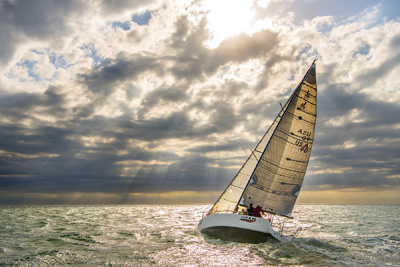 As batteries begin to drain, voltage drops, which can lead to degraded performance.
As batteries begin to drain, voltage drops, which can lead to degraded performance.
Size Matters
Weight is always a concern on a boat, and that’s still another area where lithium-ion shines. “Where a Group 31 AGM battery has 102 amp hours, a similar lithium-ion battery has a capacity of around 400 amp hours, so it’s roughly four times more capacity in a unit with the same physical size and weight,” says Maryanov.
That represents a huge amount of weight and space savings in an average yacht – space that could instead be used for stowing supplies. “That more compact footprint is a big advantage for lithium-ion,” says Xantrex’s Donald Hasler. “Lithium-Ion batteries are significantly smaller and lighter than deep-cycle AGM batteries of comparable power.”
Get Smart
As if being smaller, lighter, higher in usable capacity and longer-lasting aren’t enough of an advantage, lithium-ion batteries are also smarter than AGM cells. What that means is that unlike your current batteries, these things can actually communicate with other equipment on the boat.
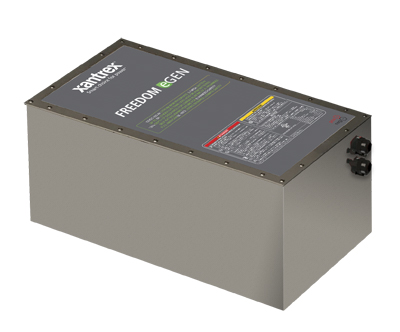
 Xantrex flexible solar panel and Xantrex Lithium Ion Battery.
Xantrex flexible solar panel and Xantrex Lithium Ion Battery.
This brings tremendous convenience. For example, connecting the battery to the boat’s onboard NEMA network means you can now easily monitor its condition and what your charger is doing at any given time, whether you’re at the helm peeking at your MFD, up on the flybridge monitoring a secondary screen, or sitting at home taking a glance at your smartphone. Want to check to see if you’re recharged after that long day on the water? There’s no need to walk down to the boat and peek under the hatch. Just pull it up on your phone or a tablet.
That’s a particularly attractive benefit if you happen to rig your boat with a solar panel or two, which is a great way to keep a steady trickle charge on the battery at all times. Solar panels are great for offsetting so-called parasitic loads, meaning the power draw of electrical devices that are on all the time like radios. Even with only five or six hours of sunlight, a pair of 100-watt solar panels can generate from 60 to 72 amp hours’ worth of power per day. That’s more than enough to power the GPS and a blender all day, with plenty of leftover power to spare.
So, What’s The Catch?
Lithium-ion batteries are new technology that deliver far superior performance to old-school lead acid cells. They give boaters far greater run times, and they have a much, much longer life span so they don’t need to be replaced anywhere near as often – something that’s not only more convenient and less expensive, but better for the environment as well. Beyond that, they’re smaller and lighter than lead acid, and they deliver the steady voltage that modern electronics require all the way through their charge cycle.
So what’s the catch?
In a word, cost. For the moment at least, lithium-ion batteries are more expensive than old-style lead acid batteries. Not just a little – they’re a LOT pricier. The hope is that this higher cost will come down as more batteries make their way into the market. But even so, if you spend a fair amount of time on your boat they’re still worth a look, even with the premium price tag.
“Over the life of the battery there is a cost savings given that lithium-ion batteries last on average seven times as long as AGM cells do,” notes Dave Maryanov. “And, through that time they provide far better performance by delivering about double the capacity and stable power output, while being smaller and lighter than the batteries they replace. You’re paying more up front, but if you put the hours in on the water there is a definite savings in the long run.”
It’s a good bet that the cost of lithium-ion batteries will drop as they come into wider use. But the benefits they provide are strong enough that a growing number of cruising boaters are still looking hard at making the switch right now. The prospect of eliminating battery headaches and never worrying about running out of juice again is an enticing proposition for anyone who spends a lot of time on the water. The opportunity to ditch the generator and finally get a decent night’s sleep could be just enough to seal the deal.

